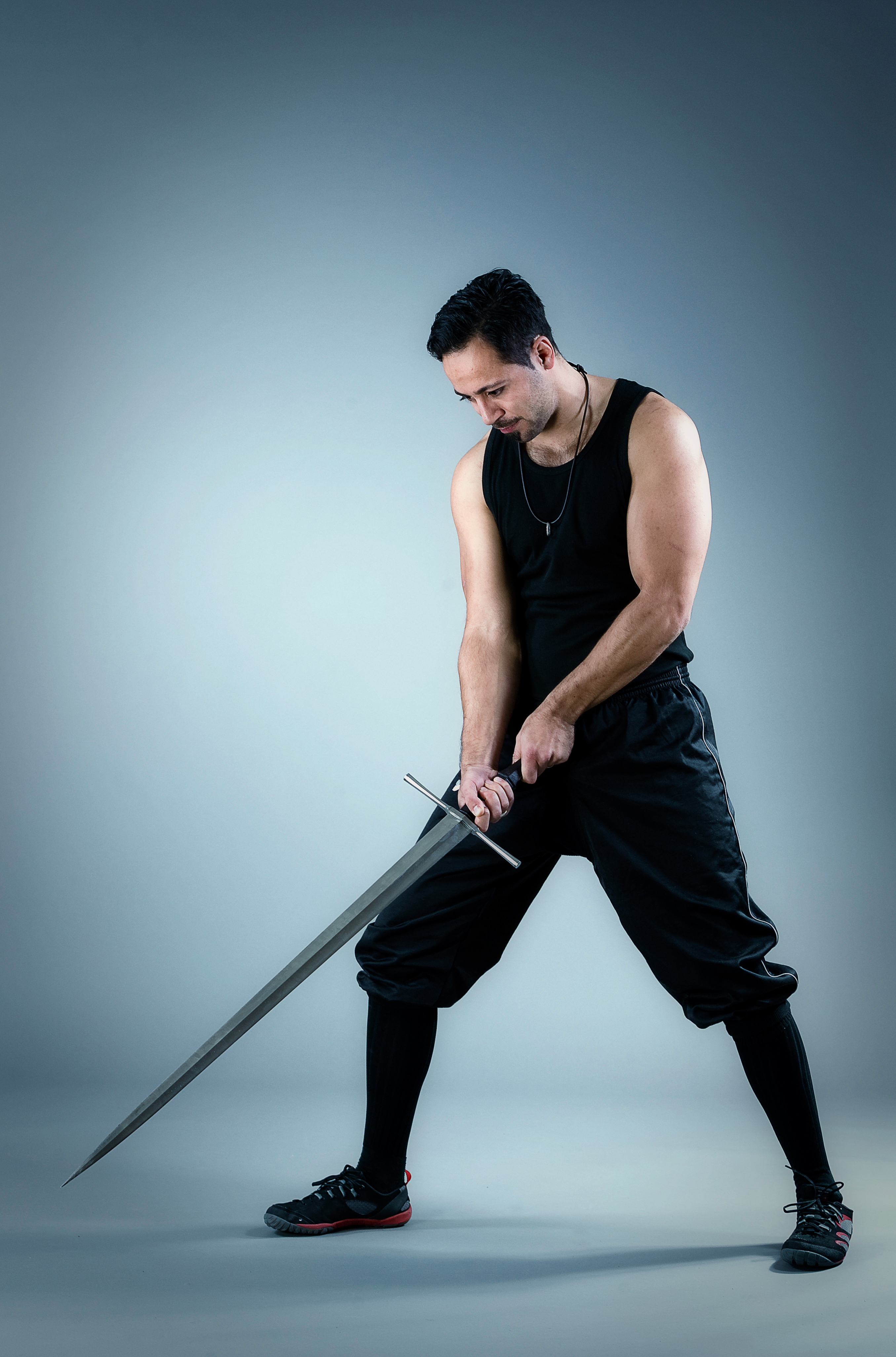The first sword I ever owned was not a training sword, it was a sharp. I still have it, and it’s unlikely I will ever sell this funny non-historical wide-bladed longsword type.
Now what this crude sword lacked in historical accuracy, it made up for in both durability and toughness. At 17, I spent many years cutting down young 1-2 inch thick poplars in the back yard after sharpening it with a stone we used for sharpening our woodcutting axe. I tried to cut many things with that sword and learned very early on that a sword is definitely not a lightsaber.
As one would expect, I wasn’t very good by modern standards. My edge alignment and structure were likely very poor, but I was cutting something and handling a sharp sword, which is something that would help me later on in my career it turns out.
Relax, you are going to cut yourself
If you are going to take this path, and be on the cutting edge of swordsmanship, then you have to accept there are some relatively minor risks involved. You are going to cut yourself here and there handling, honing, and training with sharpened, edged weapons, it is inevitable. Even if you are careful.
It’s all part of the game, so accept it and come to peace with it. In the inevitable case in which you cut yourself, simply keep some first aid supplies on hand (you should have these and training already) patch yourself up and get back to training.
The mistakes most people tend to make at first are either they are too careful, or the opposite, overconfident. Now, If you are too nervous and too ‘careful’, it is more likely that you will cut yourself while handling the sword, or damage the sword by hitting the ground, or repeatedly fail at cutting the target.
On the other hand, if you are too reckless and overconfident it is certain that over time you will inflict a more serious injury on yourself, or perhaps someone else in the vicinity. Verifiable stories exist regarding someone hitting themselves in the knee during a cutting exercise, stabbing themselves while half swording, performing a helicopter-style Zwerchhau and taking off a piece of their scalp, and even releasing a sharp sword mid-cut during a public cutting competition… just to name a few infamous incidents.
My recommendation is to treat the sharp in your hand with respect. Do not fear it. Trust in your training and your abilities. Approach this part of your practice with focus, choose to be calm, determined and methodical. Also, understand that although you may have won or placed in a few competitive tournaments, do not approach the target with the attitude that it will be no problem to do all of your favorite bouting techniques. This mentality is the path to ruin and potentially serious injury.
If you are not used to working with your sharp, start off very slow and work simple cutting patterns you are familiar with until you feel ready to progress to more technical movements.
Training with a sharp, sharpens you, and betters those around you
Practising your flow drills and solo patterns with your sharp will make you more comfortable with your sword, but really that’s just the beginning.
You won’t cut air forever, eventually you will build or acquire a cutting stand and start cutting commonly available mediums. Fruit, water bottles, pool noodles, bamboo, and of course tatami mats are popular choices. Cutting mediums like these are not perfect, but give you a set of data points that you and your clubmates can analyse, improve, and use to better your techniques and those of your training partners.
So do not be surprised when you knock the bottle off a stand and your friends have a good laugh. I recommend laughing along with them, then stepping back to consider what you need to improve. Or even better, pass the sword to a clubmate and take a moment to reflect.
You will inevitably fail cuts, everyone does. If you approach it from the wrong perspective it can be embarrassing. However, if you consider this a training exercise, and an opportunity to improve your skills, you may find you are richly rewarded.
Now, if you can’t cleanly and accurately cut a stationary tatami mat, or even a water bottle, you need to question your true understanding of how to fight with a sword. If this is hard to do in a controlled environment, realistically, how well would you do against an unfamiliar and uncooperative opponent in a chaotic environment? Especially if you were forced to fight for your life, like many of those men who wrote the manuscripts did.
What if you can’t afford a new, sleek, premium brand, sharp longsword?
In the beginning everyone wants the highly sought after Angus Trim, or Albion Longsword, but it is better to learn to cut earlier in your career with something inexpensive to teach you the simple and valuable lessons of edge alignment and cutting mechanics.
This is a common problem for many people, especially students. You buy all of your gear, your simulator, your feder, and there is no money left for a sharp, so you put it in the back of your mind and eventually forget about it.
With that said in most countries you can acquire a simple agricultural tool, which is a sort of sword itself…
The humble machete.
For a small investment you can also build a simple cutting stand from a few 2x4s, get a couple of cases of bottled water, and a sharpening stone for your machete. Now this setup is far from ideal, but it will teach you about edge alignment, edge profile and sharpness, as well as basic cutting mechanics.
Also, if you make an error, sharpening your machete will be much less stressful than having to correct an edge on a 1000 to 2000 dollar longsword.
Your training is only as complete as you make it
Many people fence in the greater HEMA community, some compete, but a much lower percentage cut. For some, they see it as a waste of time as they are uninterested in understanding the sword for anything other than scoring a point, and for others, it is currently not a part of the scope of practice in the group where they train.
I would argue that no matter how many points you can score, if you cannot execute the same techniques on a stationary cutting medium effectively, your fencing lacks martial effectiveness and your understanding of fighting with a weapon is missing a key piece to what is a complex and complicated puzzle.
When I look at the completeness of a person’s training, it should be balanced between: Drilling, Sparring, Physical Conditioning, and Cutting medium. Ideally, if one is under 40 they should also be competing and testing themselves in the ring. (I will go into this in greater detail in an upcoming article)
The road to improvement always starts on an unfamiliar and uncomfortable path. 20 years ago, the HEMA world did not have the varied resources for learning, and the immense amount of instructional videos and courses over a variety of platforms.
The vast majority of us historical fencers all look at the various sword manufacturers’ websites, share pictures, links, and debate if we can afford these beautiful objects of desire. My suggestion is to buy the best you can afford without overextending yourself. Make sure that your budget is carefully constructed so there is also money for the materials to build a stand and of course something to cut.
For me there will always be a soft spot for cutting and training with a sharp. As these exercises depart me from my daily responsibilities and bring me back to being a carefree young man with his sharp sword alone in a small Canadian forest, cutting down endless enemy saplings on a sunny Saturday summer morning.
About Lee Smith
Lee Smith is the founder of Blood and Iron Martial Arts. He is an accomplished competitive fencer and experienced instructor who along with his students has fought and taught at seminars and events across the globe. Over his career, he has trained several of the top fighters and instructors in Canada, and together with his wife Nicole, they have taught countless more through their popular Youtube channel. Currently Blood and Iron has two club chapters in Canada, and one in Silver City, New Mexico. They also have a growing online training program with students across three continents.
Check them out here:
Website: www.bloodandiron.com
Online training program: www.bloodandiron.ca/online
Youtube channel: https://www.youtube.com/c/BloodandIronHEMA




